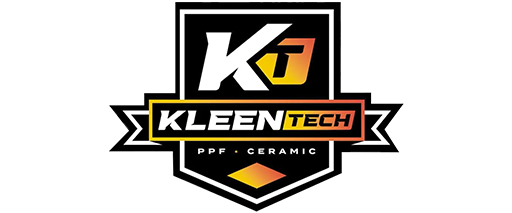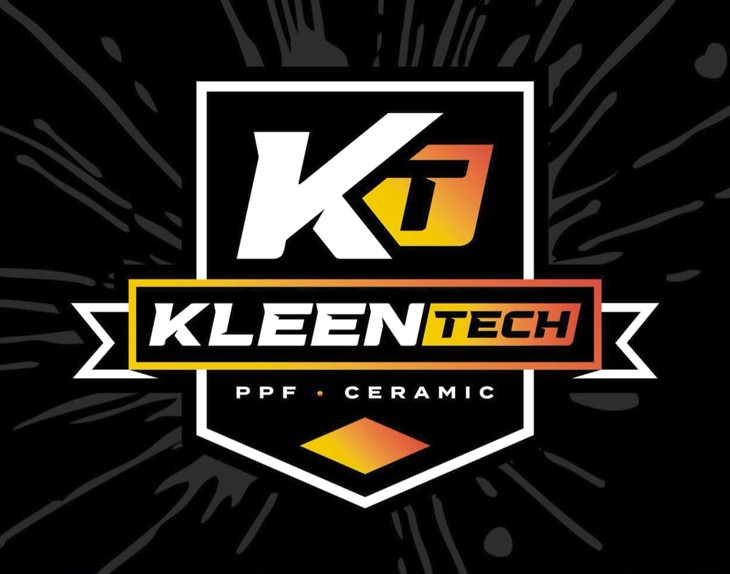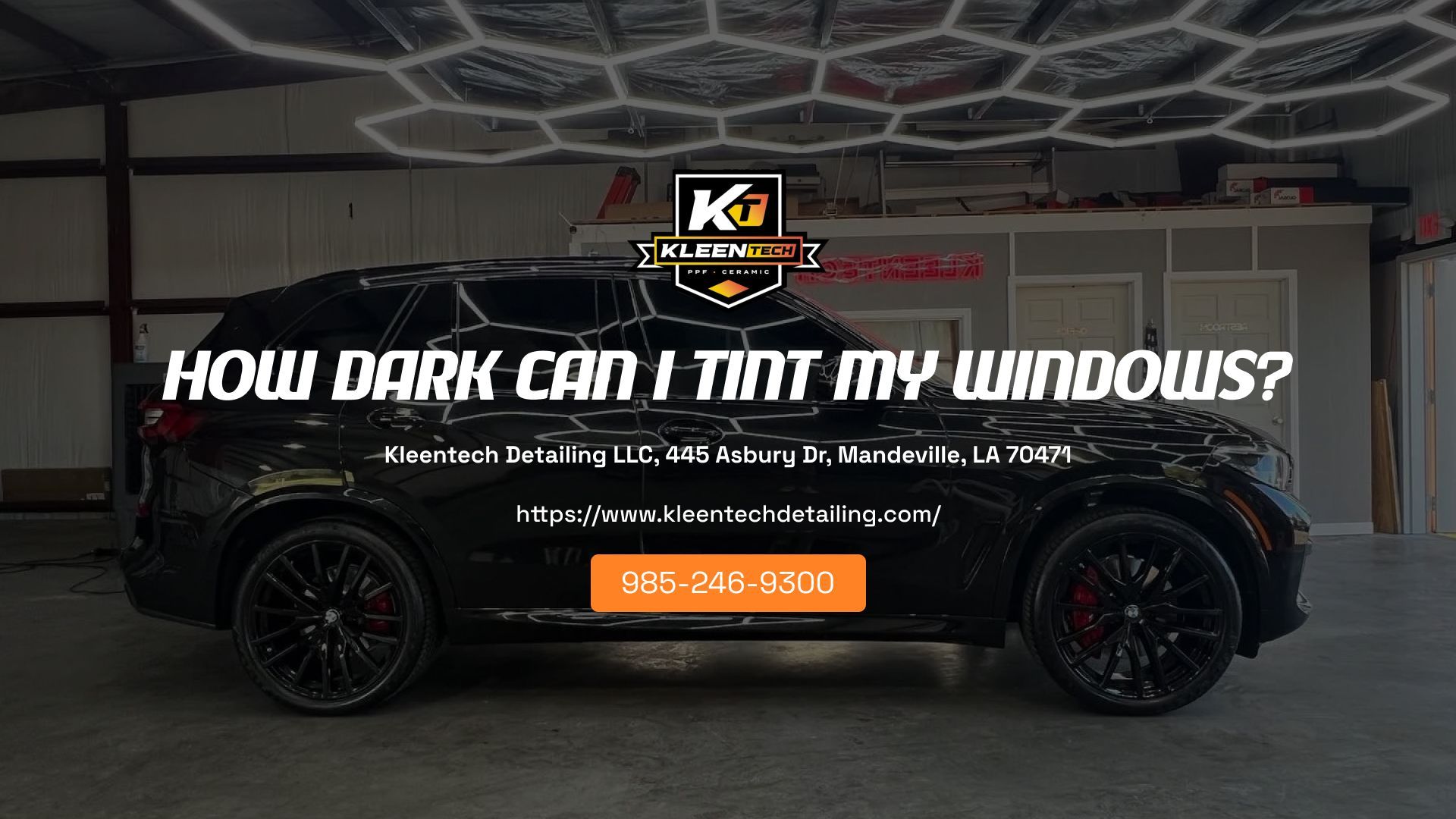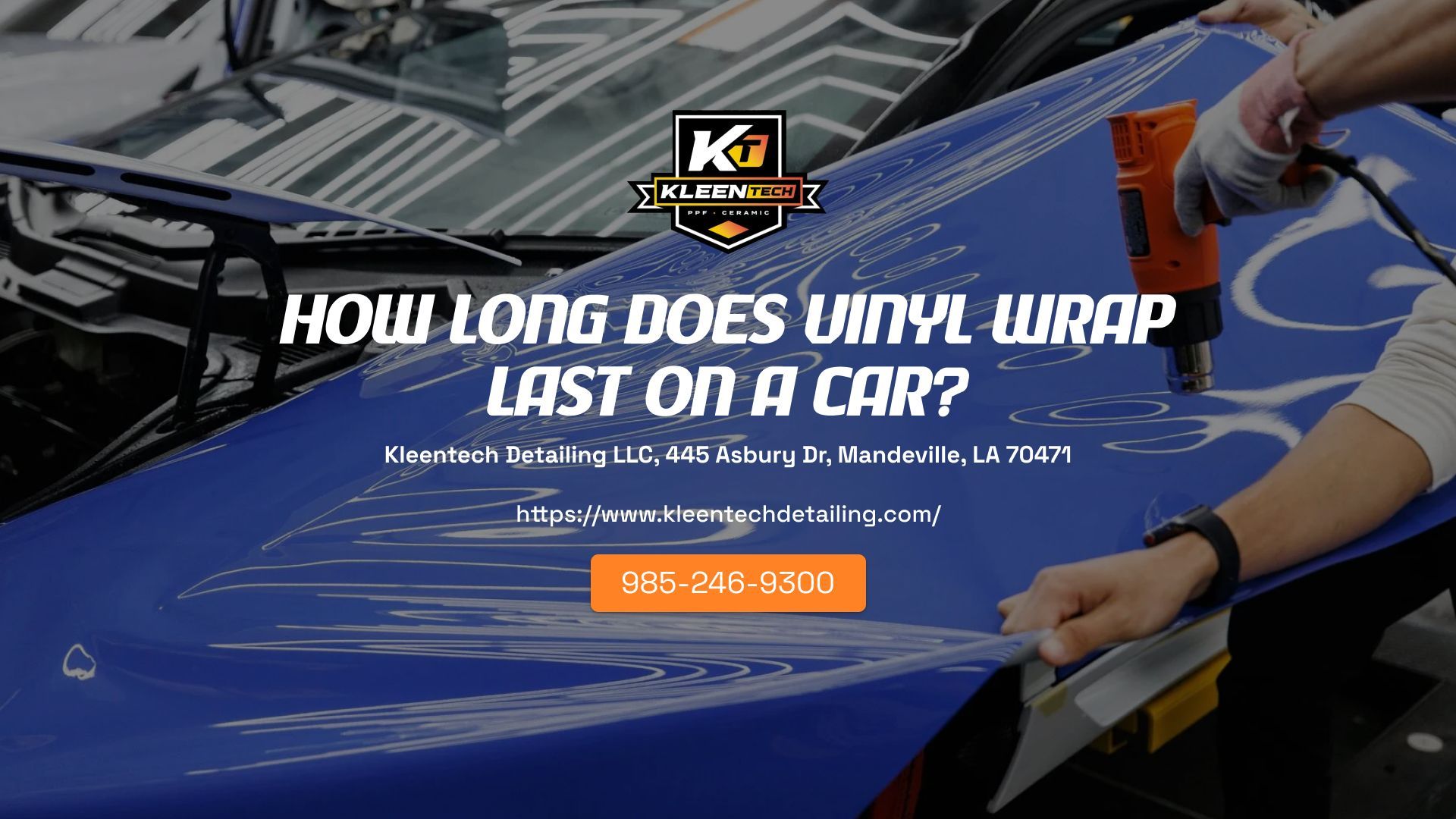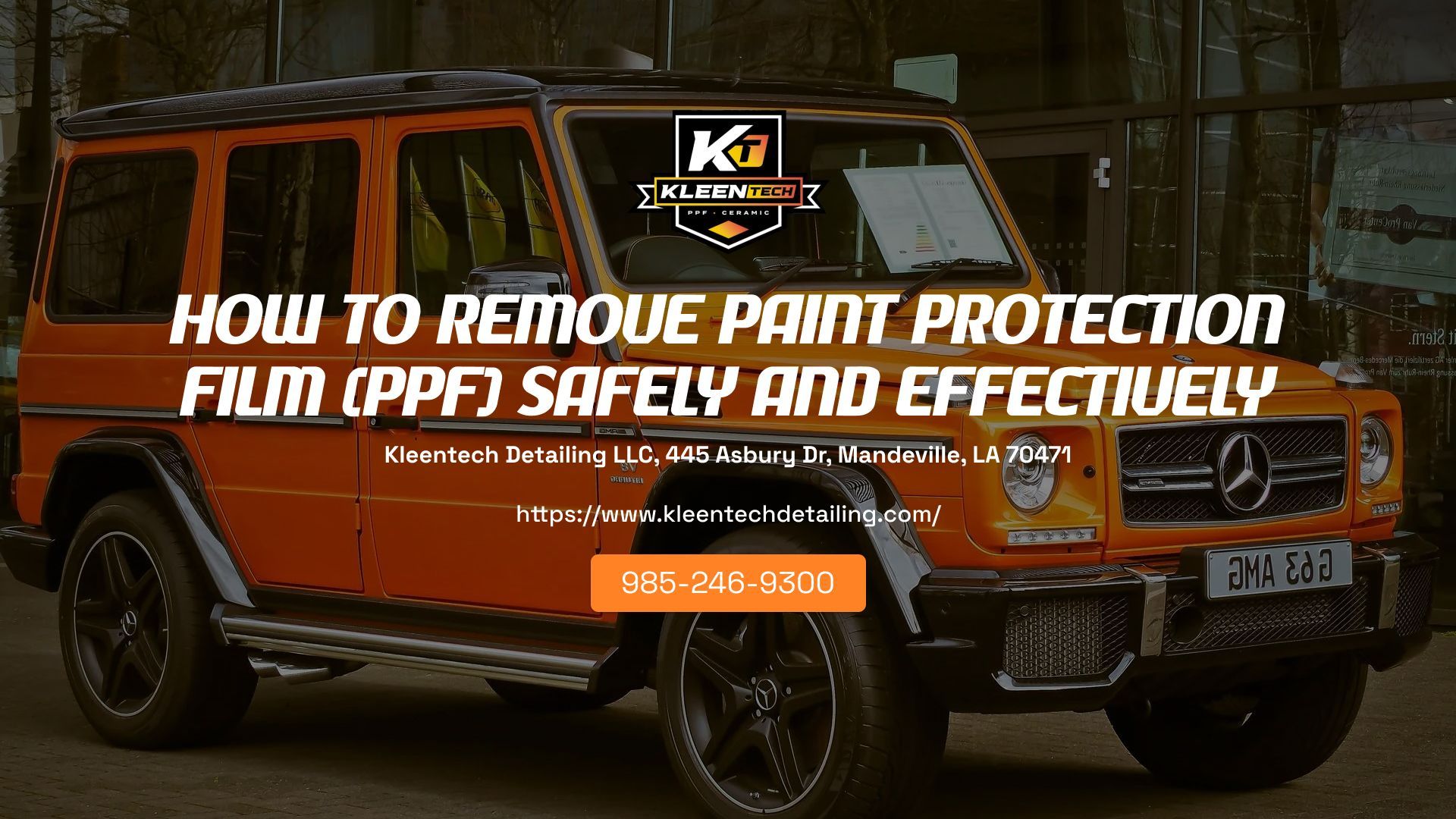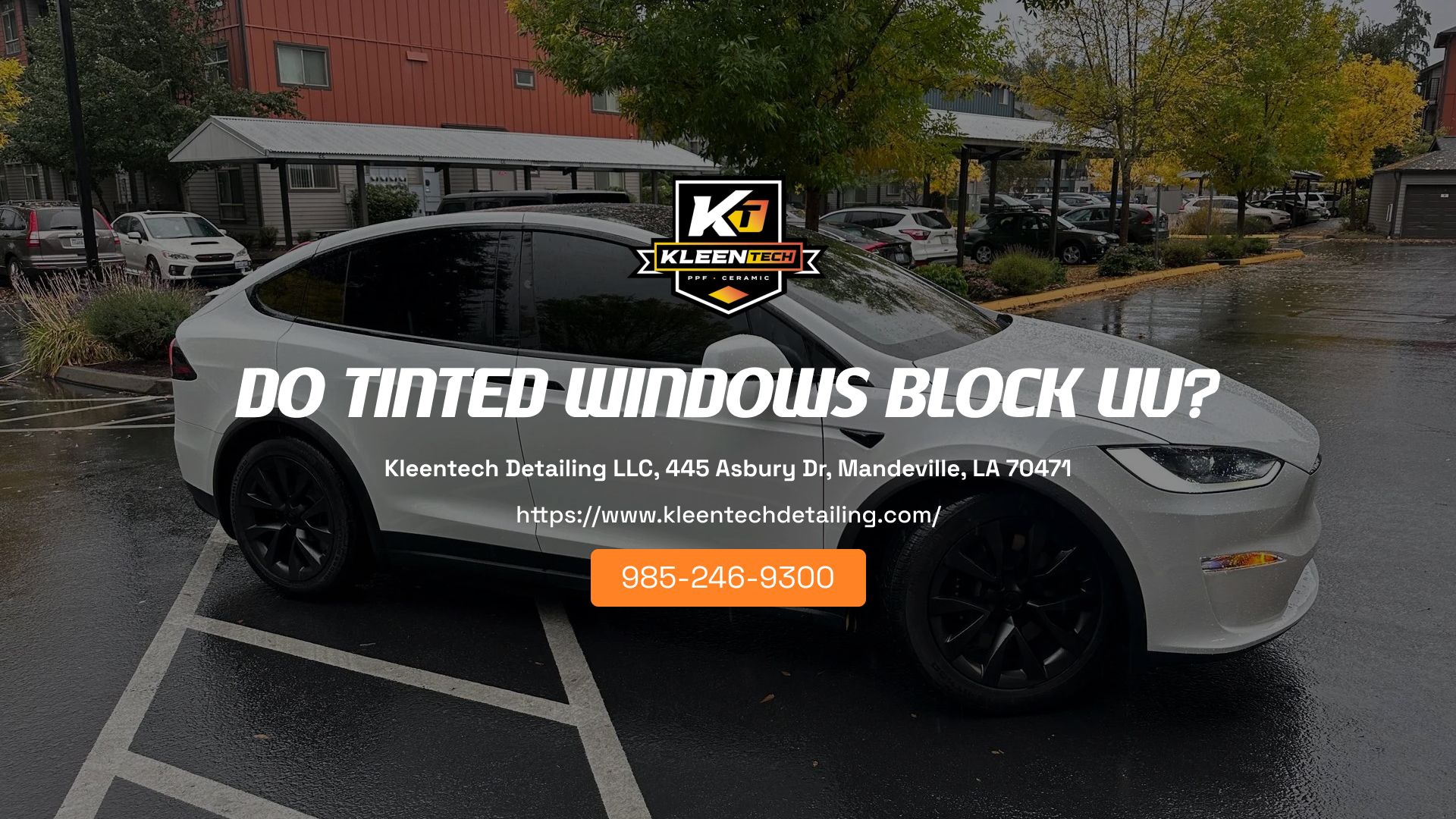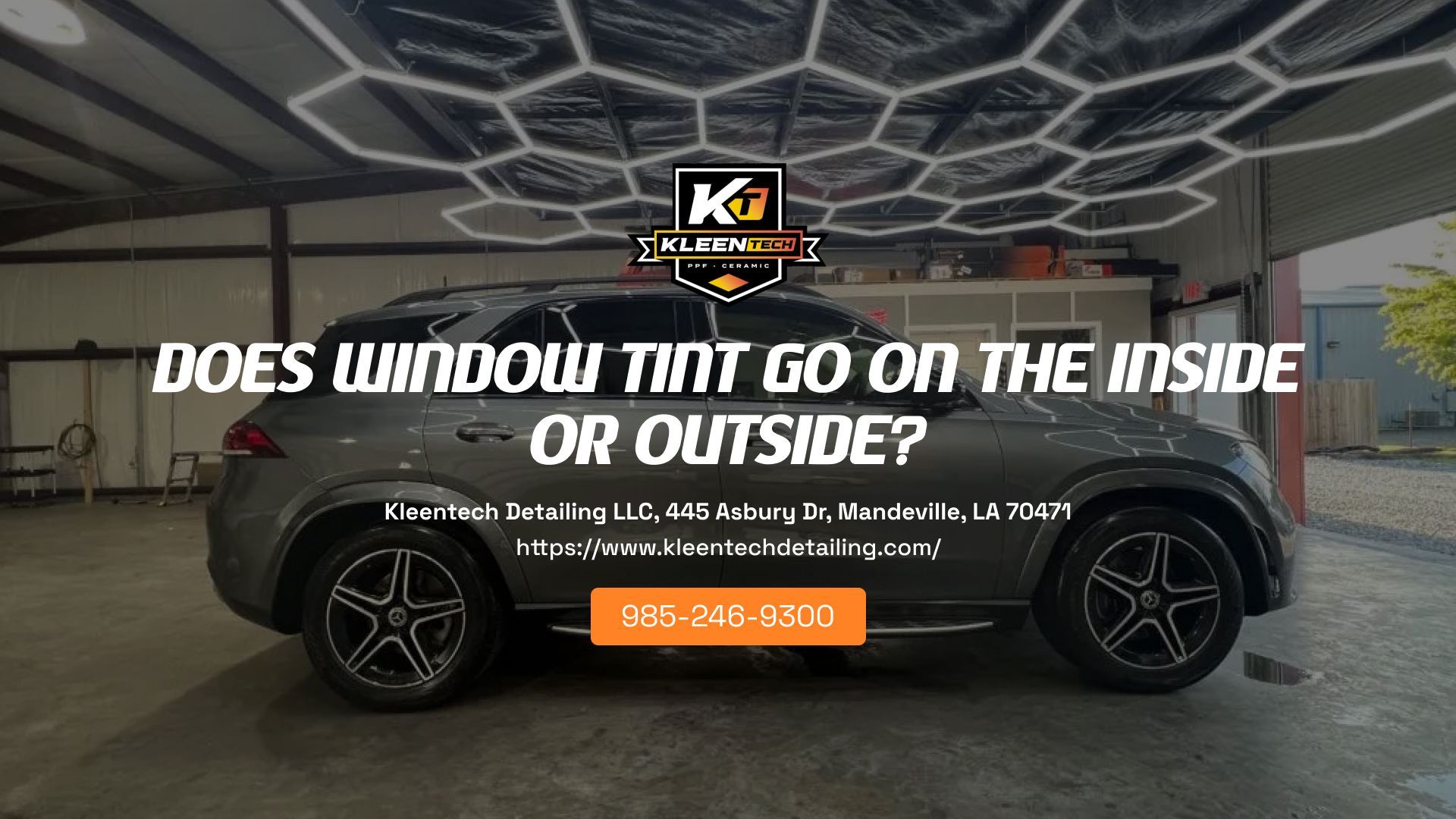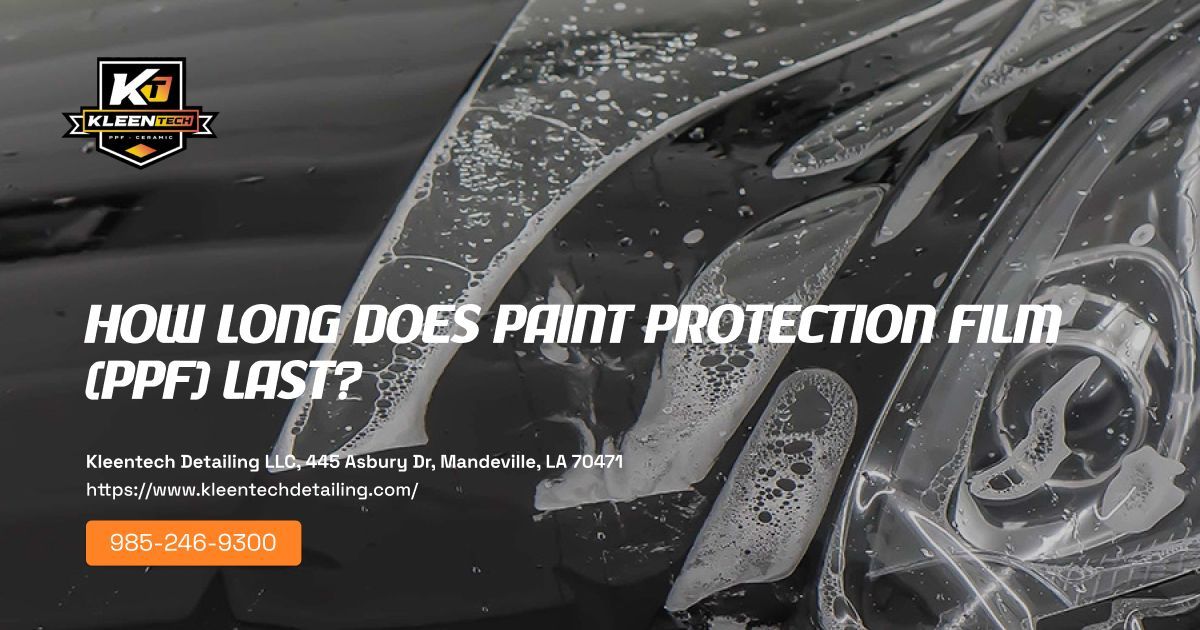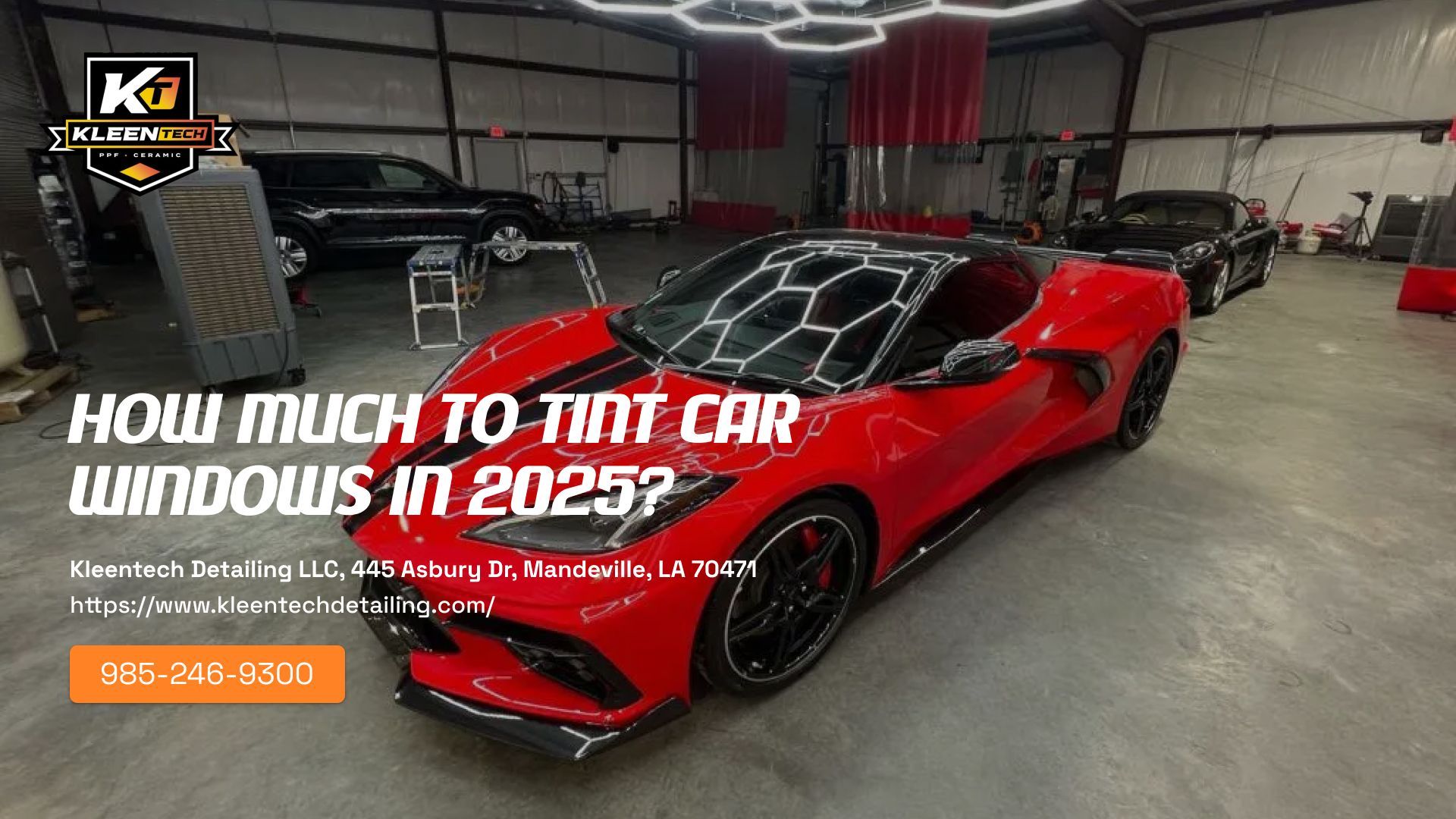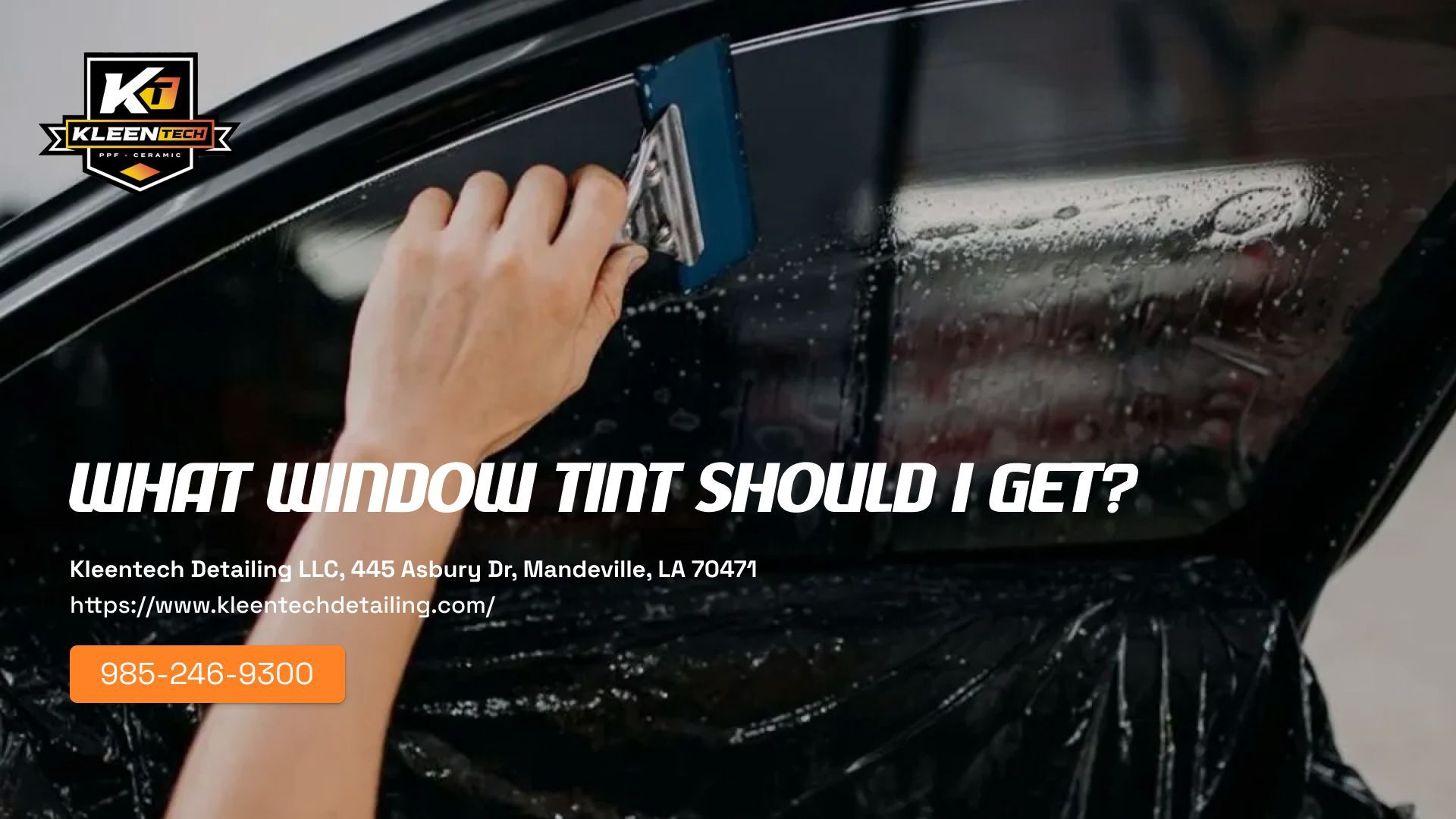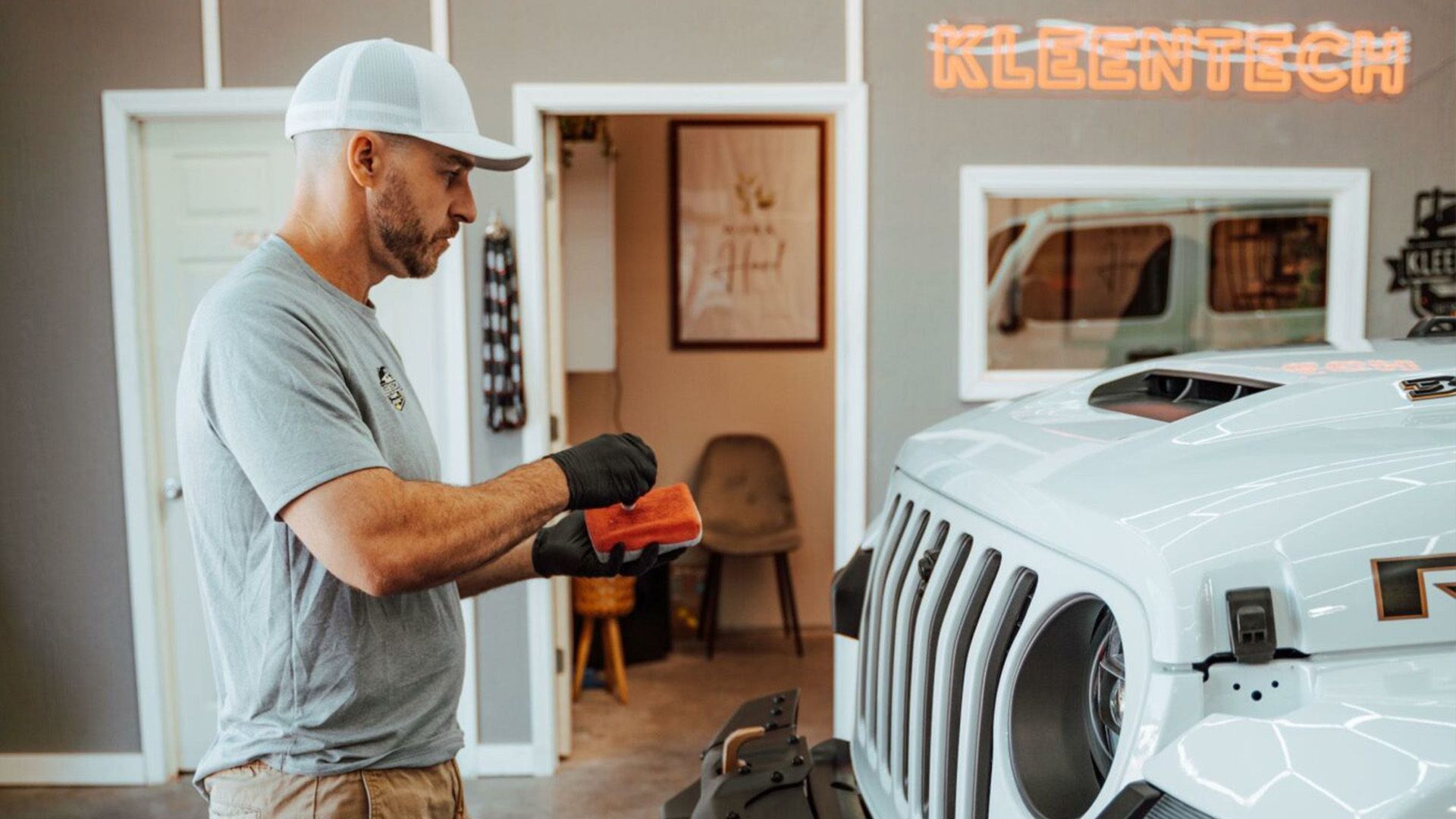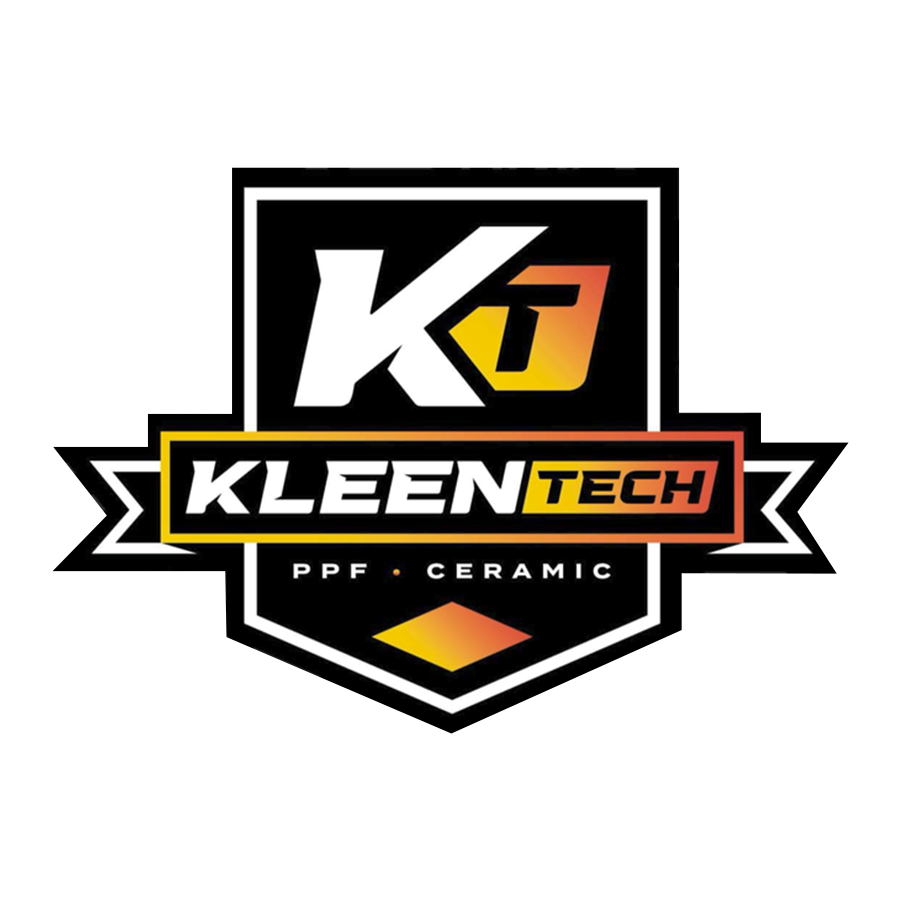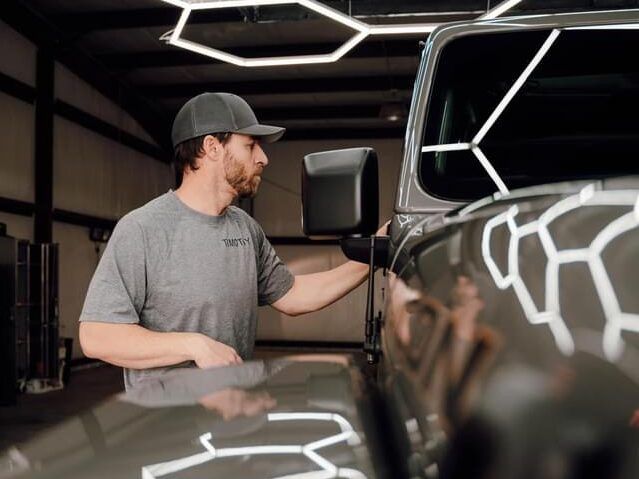How Does Window Tint Work?
Table of Contents
Wondering how window tint works? It’s a specialized film applied to vehicle glass that reduces sunlight, heat, and glare while adding privacy and protection. In this guide,
Kleentech Detailing explains how high-quality window tint keeps your cabin cooler, improves energy efficiency, and enhances both comfort and style - discover why it’s one of the best upgrades for any vehicle.
Key Takeaways
- Window tinting uses layered film technology to block UV rays, reject infrared heat, and minimize glare for cooler, safer driving.
- Ceramic, carbon, and hybrid tints are ideal for hot climates due to their high heat rejection and long lifespan.
- Mandeville VLT laws require front windows to allow at least 40% visible light transmission - always check compliance before installation.
- Professional installation offers OEM-level fitment, warranties, and longer-lasting results compared to DIY tint jobs.
- Investing in premium window tint improves comfort, resale value, and energy efficiency through reduced cabin heat and less AC use.
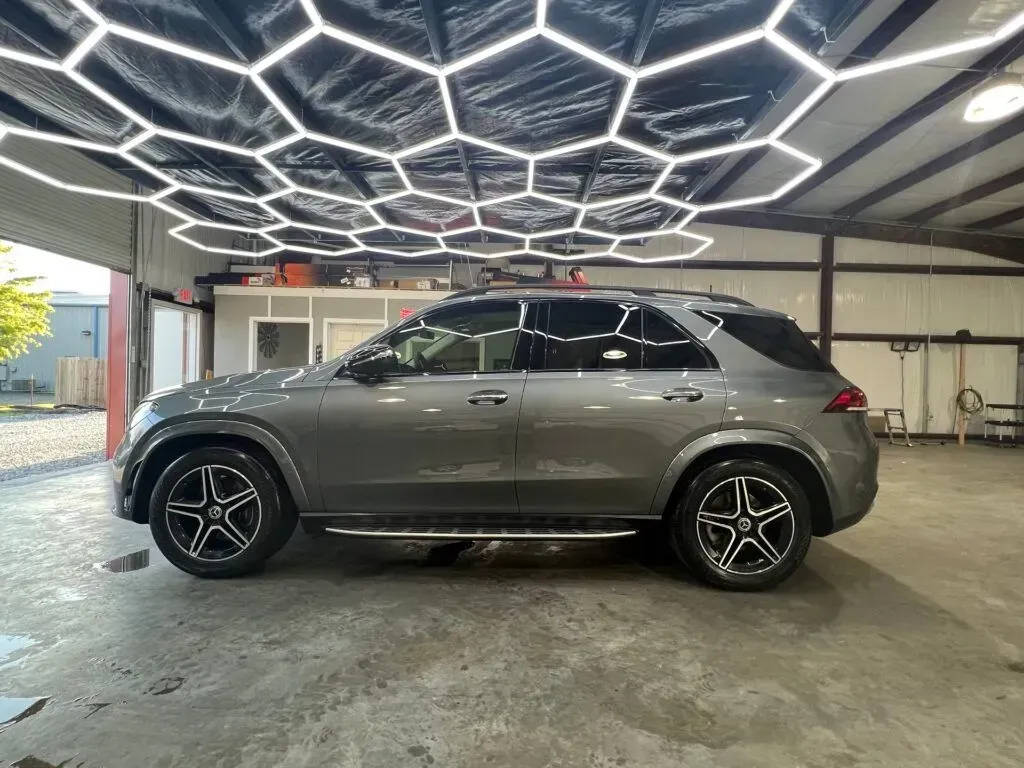
What Window Tint Is And How It Works
What Is Window Tint?
Car window tint is a thin, multi-layer film that is installed on vehicle glass to manage heat, glare, and UV radiation. Solar penetration is lowered with advanced materials such as ceramic particles, carbon films, or metal coatings that absorb and reflect sunlight.
A part of standard heat control technologies, tinting also increases security, comfort levels, and energy reduction, making it one of the top-performing auto tint solutions on the market.
Breaking Down The Layers And Materials In Window Tint
Several different layers make up each film:
- The adhesive layer keeps the film bonded securely to glass.
- The UV protection layer shields interiors from harmful rays.
- The infrared rejection layer filters heat for a cooler cabin.
- The scratch-resistant coating maintains clarity and longevity.
Some high-end films are coated with ceramic particles or a metalized coating for greater performance and longer life. There are different types of window tint available in the form of dyed, metalized, carbon, hybrid, ceramic, and crystalline window tint that possess different levels of heat rejection, clarity, and durability.
The Science Behind Heat And UV Rejection
Window tint works by controlling how light and energy pass through glass. The infrared rejection layer, UV protection layer, and ceramic particles reflect and absorb solar energy before it heats the cabin.
High-quality solar film or heat control film can block up to 99% of UV rays and around 80% of infrared heat. The anti-glare layer further enhances visibility and comfort.
By using reflective film technology, tinted windows maintain cooler interiors, protect surfaces from fading, and ensure clear visibility even in bright or hot driving conditions.
Benefits Of Window Tinting
The benefits of window tint go far beyond style - it's a total heat control, privacy, glare reduction, and interior safeguard solution. Learn the top advantages below to discover why tinting enhances comfort, security, and long-term investment.
Increasing Comfort While Decreasing Heat
Heat reduction is among the most worthwhile perks of window tinting. High-end films such as ceramic and carbon tint reject 85% of infrared (IR) radiation, which cools down the cabin while decreasing air conditioning consumption. It enhances comfort, increases fuel economy, and obtains long-term return on investment, particularly in warm, humid regions such as Mandeville.
Protecting Passengers And Interior Surfaces
Window tint blocks up to 99% of harmful UV rays, helping prevent skin damage and reducing the risk of sun-related conditions. It also protects your interior, including seats, dashboards, and electronics, from cracking, fading, and heat deterioration. Security films add an extra layer of safety by reinforcing the glass, making it more resistant to shattering during accidents or break-in attempts.
Window Tint Laws and Legal Requirements
Window tint laws vary by location and depend on VLT (Visible Light Transmission) - the percentage of light that passes through your windows. Complying with these rules maintains safe visibility, ensures safety and security, and prevents legal issues.
Legal Exemptions For Window Tint
Drivers with certain medical conditions may qualify for legal exemptions that allow darker tinting than usual. These exceptions still require proper documentation and adherence to local VLT standards. Always check local regulations before installation to stay in compliance.
Penalties For Illegal Window Tint
Using an illegal tint film can lead to fines, removal orders, or failed vehicle inspections. Cars with overly dark or overexposed windows are more likely to be stopped by law enforcement.
Example:
In Mandeville, window tint laws are based on VLT (Visible Light Transmission) standards, which regulate how much visible light must pass through your car windows. Front side windows must allow at least 40% VLT, rear side windows at least 25%, and rear windows no less than 12%. These visibility requirements are designed to support road safety, law enforcement visibility, and driver awareness.
Violating Louisiana tint laws can lead to escalating penalties: up to $150 for a first offense, $250 for a second, and $350 for third or subsequent violations. To avoid fines, inspection issues, or forced tint removal, it’s essential to choose legal, VLT-compliant tint film installed by certified professionals like Kleentech Detailing.
Types Of Window Tint Films
There are six main types of automotive window tint, each offering different levels of heat rejection, UV protection, visibility, and durability. Choosing the right film depends on your climate, budget, and performance needs.
1. Dyed Window Tint
Dyed tint is the most affordable film, made by layering dye between adhesive and protective coatings.
- Best for: Aesthetics and basic privacy
- Heat rejection: Low to moderate
- Lifespan: 1–3 years
- Drawback: Fades over time and offers minimal IR protection
Note: Budget-friendly but not ideal for hot or humid climates like Mandeville.
2. Metallic (Metalized) Window Tint
Metalized film reflects heat using tiny metallic particles embedded in the film layers.
- Best for: Strong glare and heat reduction
- Heat rejection: High
- Bonus: Reinforces glass strength
- Downside: May interfere with GPS, cell, or radio signals
Note: Good for heat, but less ideal if you rely on in-car electronics.
3. Carbon Window Tint
Carbon tint contains carbon particles that block infrared light without creating a mirror effect.
- Best for: Heat insulation and a matte finish
- Heat rejection: Up to 50–60%
- UV protection: Excellent
- Signal interference: None
Note: Popular in warm climates due to its durability and signal-safe design.
4. Hybrid Window Tint
Hybrid tint combines dyed and metallic layers to balance performance, cost, and appearance.
- Best for: Balanced heat rejection and clarity
- Heat rejection: Moderate to high
- Glare reduction: Reliable
- Visual quality: Neutral
Note: Great all-rounder for those seeking solid performance without premium cost.
5. Ceramic Window Tint
Ceramic tint is the top-performing film, using nano-ceramic particles that block heat and UV without darkening visibility.
- Best for: Maximum comfort, clarity, and performance
- Heat rejection: Up to 85% IR rejection
- UV protection: Blocks 99% of harmful rays
- Lifespan: 10+ years
- No signal interference
Note: Ideal for Mandeville’s high temperatures and humid conditions.
6. Crystalline Window Tint (High-Transparency Films)
Crystalline films are designed for drivers who want heat rejection without a dark tint.
- Best for: Legal compliance + maximum visibility
- IR rejection: High
- VLT: Up to 70% (appears nearly clear)
- Use case: Medical exemptions or compliance with strict tint laws
Note: Great for drivers needing legal clarity with premium heat protection.
Is Ceramic Tint Worth It?
Yes - ceramic window tint is absolutely worth it. Unlike traditional tint, it doesn’t fade, interfere with signals, or distort vision. The nano-ceramic film reflects heat, blocks 99% of UV rays, and filters IR radiation. It also improves energy efficiency, reduces air conditioning use, and adds a luxurious finish. While the upfront cost is higher, the long-term ROI is exceptional due to its durability and superior protection.
Window Tint Installation Options
When it comes to window film installation, you can choose between DIY (Do It Yourself) or professional service.
DIY And Professional Tint Installation
DIY Tint Installation
Pros:
- Lower upfront cost.
- Convenient for small projects or temporary use.
- Allows personal customization and flexibility.
Cons:
- Prone to air bubbles, creases, or misalignment.
- Often lacks proper tools and heat-shrinking techniques.
- May fail to meet VLT (Visible Light Transmission) or legal standards.
- Shorter lifespan due to uneven application or dust contamination.
Professional Tint Installation
Pros:
- Uses precision tools like heat shrinking, edge trimming, and squeegeeing for perfect fitment.
- Meets OEM standards and local tint regulations.
- Offers warranties, cleaner finishes, and longer durability.
- Ensures proper safety and security with the correct handling of PPE and certified materials.
Cons:
- Higher cost than DIY.
- Requires scheduling and professional availability.
- Professional tint installation is ideal for long-term performance, safety, and compliance - especially when installing premium films such as ceramic window tint or nano-ceramic film.
The Professional Window Tint Installation Process
Certified experts follow a precise process to ensure the film adheres perfectly:
- Cleaning & Preparation – Removing all dust and debris for a clean surface.
- Heat Shrinking – Shaping the film over bent glass.
- Wet Application – Placing the film with a special solution in order to exclude bubbles.
- Squeegeeing & Edge Trimming - Removing air pockets & sealing clean edges
- Curing – Allowing it to dry and bond entirely.
During
tint installation, professionals wear PPE for protection as well as follow OEM guidelines to respect product warranties as well as compliance.
Window Tint Cost, Lifespan, and Maintenance
What Affects The Cost Of Window Tint?
Pricing varies based on several factors:
- Film Type: High-performance films such as ceramic window tint, carbon window tint, and hybrid window tint offer advanced IR and UV rejection, driving higher cost but better performance.
- Number Of Windows: Larger vehicles or full-coverage installations require more material and labor.
- Installation Quality: Professional window film installation ensures cleaner application and longer lifespan.
While premium films cost more initially, they save money long-term through reduced energy use, less interior protection wear, and enhanced comfort.
Want to compare? Check our guide: How Much To Tint Car Windows.
How Long Does Window Tint Last
Tint lifespan depends on material quality and care.
- Dyed window tint: typically lasts 1–3 years.
- Carbon window tint: can last 5 years or more.
- Ceramic window tint: often lasts 10 years or longer due to its advanced security film structure, UV protection layer, and resistance to fading, bubbling, or peeling.
Regular maintenance helps preserve performance and clarity, especially in hot or sunny climates.
When To Replace Or Remove Window Tint
Replace or remove your window film when it begins to fade, peel, or bubble - these signs reduce visibility, comfort, and UV protection. Upgrading to modern ceramic window tint or heat control film instantly restores clarity, style, and safety.
For best results, schedule periodic inspections with certified installers to maintain top performance, avoid damage, and keep your tint looking like new.
Privacy, Safety, And Visibility With Window Tint
Enhancing Privacy And Security
Privacy film shields valuables and deters theft. The built-in safety layer and privacy tint keep interiors hidden while adding strength to your glass - protecting both your privacy and safety.
Improving Visibility And Nighttime Safety
Glare reduction film with an anti-glare layer enhances visibility in bright daylight and nighttime driving. It filters harsh light without darkening your view, providing comfort and compliance with VLT standards.
Boosting Resale Value
Window tint adds aesthetic appeal and functional value, both part of vehicle enhancements. The improved comfort, protection, and finish often increase resale value and deliver a long-term ROI advantage.
Get A Free Window Tint Quote Today
Looking for professional automotive tinting? Kleentech Detailing offers certified window film installations in Mandeville and nearby areas. Our technicians use top-rated products following all OEM standards. Get a free quote today and enjoy lasting comfort, privacy, and protection.
FAQs
Will window tint reduce heat?
Yes. Solar film and heat control film reflect IR rays, decreasing cabin temperatures and energy usage.
Is window tint at night safe?
Yes, when you are employing glare reduction film with a suitable VLT, it ensures you can see with reduced glare.
How long does ceramic tint last?
The ceramic window tint or nano-ceramic film usually lasts more than 10 years with its UV shield layer as well as infrared reject layer.
Can I remove old tint myself?
You can do it yourself using DIY methods or a professional take-off tint for clean, damage-free results.
What is the best tint for warm climates?
In warm, humid regions such as Mandeville, where summer highs regularly hit the 90s and humidity remains elevated, carbon window tint, or heat-rejection window tint, is your best choice due to its excellent IR blockade properties.
